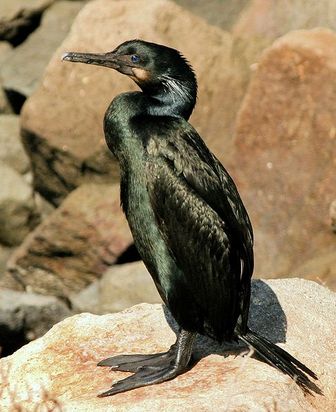Brandt's cormorant
Brandt's Cormorants feed either singly or in flocks, and are adaptable in prey choice and undersea habitat. It feeds on small fish from the surface to sea floor, obtaining them, like all cormorants, by pursuit diving using its feet for propulsion. Prey is often what is most common: in central California, rockfish from the genus Sebastes is the most commonly taken, but off British Columbia, it is Pacific Herring. Brandt's Cormorant have been observed foraging at depths of over 40 feet.

Original source: originally posted to Flickr as Brandt's Cormorant
Author: Teddy LlovetPermission(Reusing this file)This image, which was originally posted to Flickr.com, was uploaded to Commons using Flickr upload bot on 23:58, 9 July 2010 (UTC) by Howcheng (talk). On that date it was licensed under the license below.This file is licensed under the Creative Commons Attribution 2.0 Generic license.You are free:to share – to copy, distribute and transmit the work
The Brandt's cormorant is classified as Least Concern. Does not qualify for a more at risk category. Widespread and abundant taxa are included in this category.
Sociable in all seasons, Brandt's Cormorants are often seen flying in long lines, low over the water. They roost together and feed in offshore flocks, often mixed with other seabirds. They are sometimes even seen foraging in association with sea lions. They catch most of their food under water, diving up to 150 feet. back to top Diet - A wide variety of fish make up the Brandt's Cormorant's diet. Some shrimp and crabs are also taken. More
The Brandt's Cormorant (Phalacrocorax penicillatus) is a strictly marine bird of the cormorant family of seabirds that inhabits the Pacific coast of North America. It ranges, in the summer, from Alaska to the Gulf of California, but the population north of Vancouver Island migrates south during the winter. Its specific name, penicillatus is Latin for a painter's brush (pencil of hairs), in reference to white plumes on its neck and back during the early breeding season. More
The Brandt's Cormorant has a large range, estimated at 100,000 to 1,000,000 square kilometers. It is native to North America and lives in neritic and coastal or supratidal marine habitats. The population of the bird is estimated to be 230,000 individuals. Current population trends are not approaching the threshold criteria levels for population decline that would necessitate inclusion on the IUCN Red List. Because of the current population trends, at this time Brandt's Cormorant has an evaluation level of Least Concern. More
A large cormorant of the Pacific Coast, the Brandt's Cormorant is found only in marine environments. More
Brandt's Cormorants feed either singly or in flocks, and are adaptable in prey choice and undersea habitat. It feeds on small fish from the surface to sea floor, obtaining them, like all cormorants, by pursuit diving using its feet for propulsion. Prey is often what is most common: in central California, rockfish from the genus Sebastes is the most commonly taken, but off British Columbia, it is Pacific Herring. Brandt's Cormorant have been observed foraging at depths of over 40 feet. More
Brandt's Cormorant, the bird of our illustration, is found on the Pacific coast from the state of Washington southward to Cape St. Lucas at the southern extremity of Lower California. In its habits it is gregarious and collects in great numbers wherever its natural food of fish is plentiful. These flocks present a very odd appearance and their long necks appear as numerous black sticks on the watery background. Mr. Leverett M. More
Bent Life History for the Brandt's Cormorant - the common name and sub-species reflect the nomenclature in use at the time the description was written. BRANDT CORMORANT PHALACROCORAX PENICILLATUS (Brandt) HABITS This large, heavy, well-marked species is perhaps the best known, the most abundant, and the most characteristic cormorant of our Pacific coast, being found in all suitable localities from southern Alaska to Lower California. More
Brandt's Cormorants flying in the mist at South East Farallon Island. SFBayAxis. More

Original source: Blake Matheson
-Blake Matheson -Author: Blake Matheson
Permission: Some rights reserved
Family : Phalacrocoracidae
Genus : Phalacrocorax
Species : penicillatus
Authority : (Brandt, 1837)

